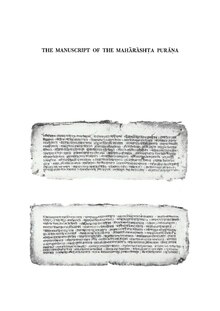|
Maharashta PuranaMaharashta Purana is a contemporary poetic chronicle of the Maratha invasions of Bengal. ManuscriptDiscovery Kedarnath Majumdar came across the palm-leaf manuscript — in eleven folios — while collecting biographies of regional poets in Mymensingh c. 1902.[1] It remains the only extant manuscript and is currently conserved at the Manuscript Library of the Bengali Department of the University of Calcutta.[2][3] EditionsIn 1908, Byomakesh Mustafi edited the text for the first time; it was published in Sahitya Parishat Patrika with an introduction and accompanying notes.[4][a] In 1924, Prof. J. N. Samaddar of Patna University published an abridged translation in English with a brief introduction and notes.[4] In 1930, T. C. Dasgupta re-translated the chronicle to English, for a journal published by the University of Calcutta.[5][b] An improved English translation—alongside a critical transliteration and commentary—was published by Edward C. Dimock and Pratul Chandra Gupta in 1965 from the University of Hawaiʻi Press.[6] DatingA date in the Bengali calendar—Sanibar, 14th of Pous, saka 1672, sala 1158 (29 December 1751)—is mentioned in the colophon; it might have been the date of completion of composition by the author or the completion of copying by the scribe but provides the terminus ante quem.[3] From the text's conclusion with the death of Bhaskar Ram Kolhatkar (d. March 1744), a terminus post quem of c. 1745 can be imposed.[7] AuthorThe Purana was written by Gangaram Dev Chowdhury, a Hindu Kayastha from Dharishwar village who served as a scribe for the local Muslim zamindar, among his other works were Shuk Sambad and Labkush Charitra.[8] GenreA long narrative poem of 716 lines, the meters vary in accordance with the context;[6] despite the name, there is no significant resemblance to the eponymous epical genre.[5] Kumkum Chatterjee locates the text as part of the Mangal-Kāvya corpus; however, Dimock and Gupta held it as a "text of pure secular history."[7] ContentThe raids are covered from their start till the assassination of Bhaskar Pandit.[3] That the last line of the manuscript reads "Thus ends the first part of Maharashtra Puran [...], called Bhaskara-Parahaba", it has been suggested that Gangaram might have had drafted successor volumes.[3] LegacyThe text remains among the only few works of contemporary vernacular literature to describe the Maratha raids;[9][c] as such, it has been used by historians like Jadunath Sarkar and others to document the history of Marathas and Bengal.[5] Tapan Raychaudhuri uses its example to argue that the premodern literary culture in Bengal did not register any memory of the Islamic Rule in Bengal as uniquely oppressive or tyrannical — such emotional affects would be only produced during the Indian independence movement in service of constructing an imagined national identity around Hinduism.[10] NotesReferences
Bibliography
|